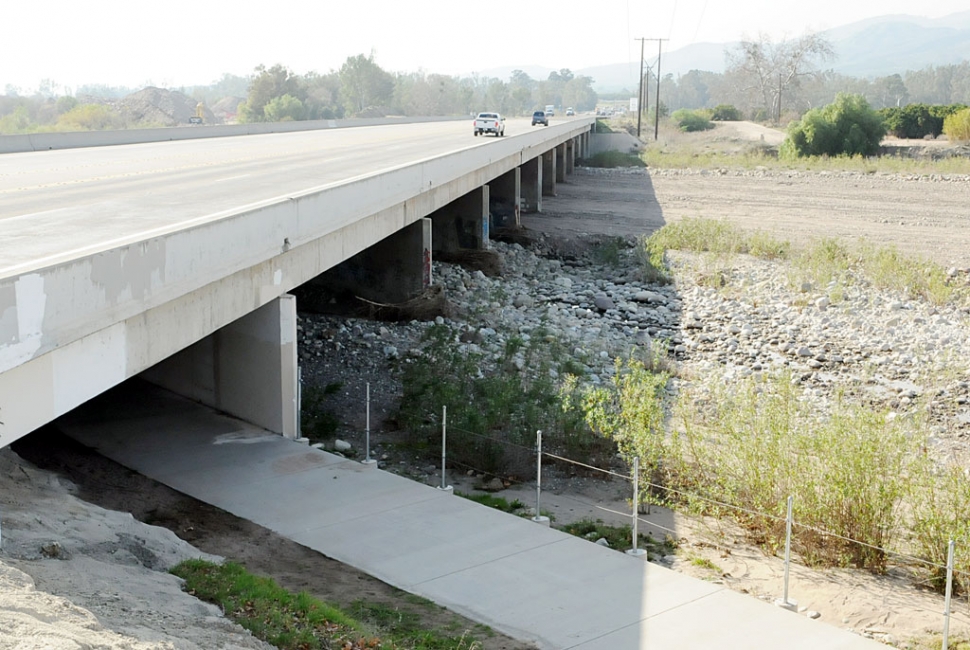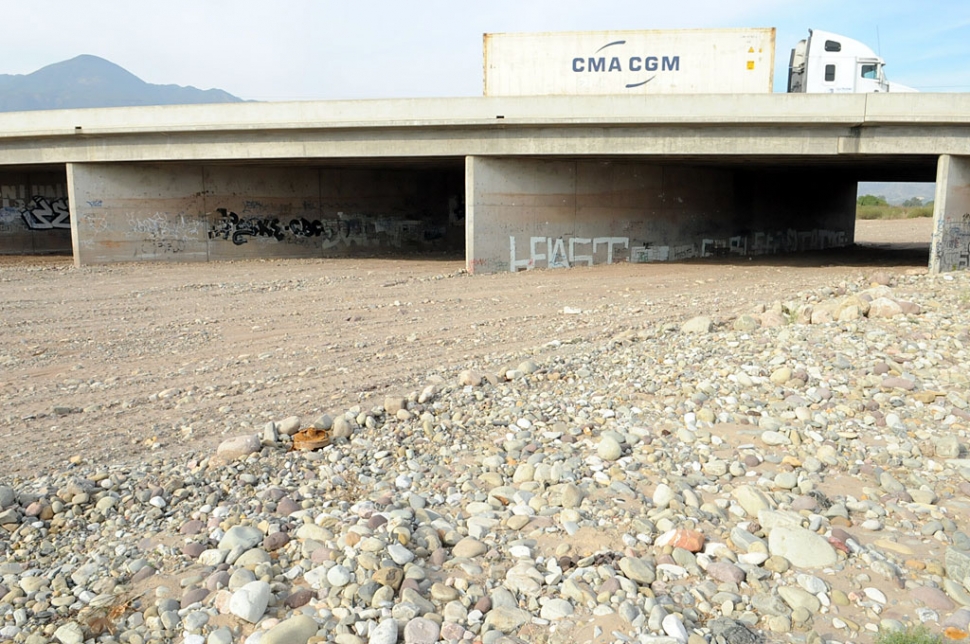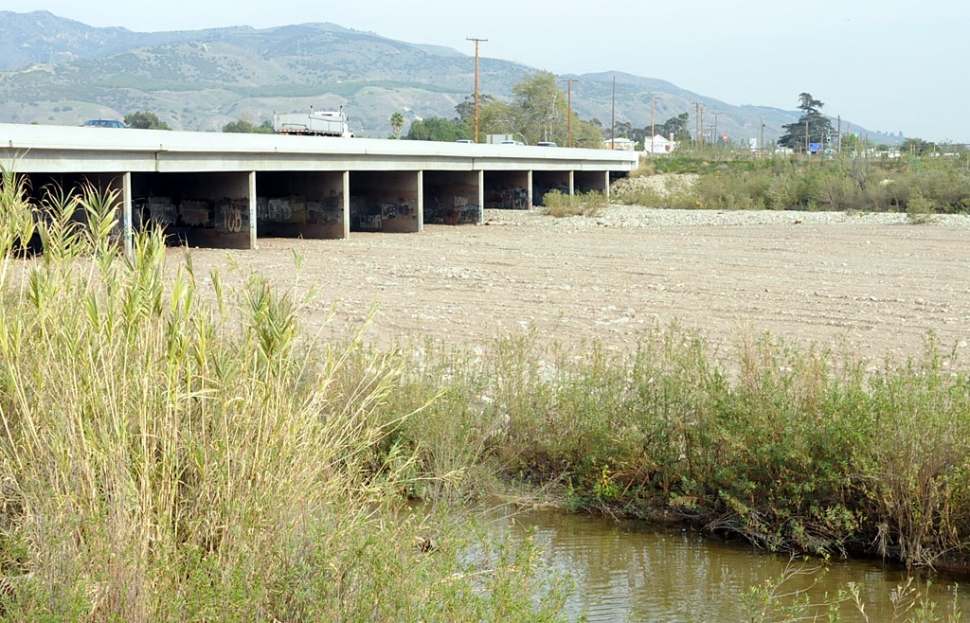|
Sespe gets debris TLC
 A westward view of the Fillmore bridge crossing Sespe Creek shows the recent cleanout of rock and debris at the center. Upland Rock has completed the work of grading and removing debris which accumulated over the years at the center of the bridge. The rock presents a flood threat for the western part of the city. By Jean McLeod — Wednesday, February 1st, 2012
  Sespe Creek is getting a great deal of attention these days. In addition to the Ventura Watershed Protection District putting in a new levee, Upland Rock at Sespe Creek is also working on removing the large amount of collected debris blocking the channel under the east Sespe Creek bridge located on Highway 126. Sespe Creek, which originates above 5,000 feet elevation in the Los Padre National Forest, drains a major portion of the Sierra Madre Mountains and 342 acre of Sespe Wilderness into the Santa Clara River. The name Sespe can be traced to the Chumash Indian village, called Cepsey or Sek-pe in a 1791 California land grant. It was important to the native tribe, which foraged and hunted along the creek. Sespe Creek is the largest of the 30 tributary creeks running into the Santa Clara River, which is the longest relatively natural river remaining in Southern California. The Sespe is 51 miles long and joins the Santa Clara River in Fillmore through an east and west channel that both cross Highway 126. But, according to James Sandoval, owner of Sespe Materials (the company that mined the creek for many years), a significant flood years back diverted the water’s flow to the east channel. Sandoval, at the time, wanted to restore the flow to the west channel, but a Fillmore homeowner refused him needed access to do the work. Sandoval said, “It has been at least 20 years since the west channel has flowed.” The County of Ventura has designed and mapped out all rivers and creeks that flow within its boundaries which includes Sespe Creek. But in the past decade, several fires have burned hundreds of acres of the dense chaparral around Sespe’s watershed and the creek has been laden with considerable sedimentation which fills in many of the deep pools that the lower Sespe is known for. The debris and sediment deposits under the Highway 126 west Sespe Creek overpass (which is long and wide enough to accommodate two lanes in each direction plus and ample median and shoulders) are preventing a proper flow and shifting the streambed in both left and right directions of the designated map. This is also causing flooding of the ranches along its banks. Some areas of debris, which includes sand, rock and vegetation, have reached over nine feet high with the creek itself 14 feet above grade. One of the main culprits causing problems is the non-native plant Arundo, which has taken over large areas of both Sespe Creek and the Santa Clara River. A tall perennial, cane-like grass that resembles bamboo, Arundo is an invasive species that during flooding rhizomes break off and travel downstream where it continues to invade due to its aggressive growth and ability to survive. Once Arundo is established the area requires continual costly cleanup and maintenance because it creates a fire hazard, flood hazard, sedimentation, and erosion. The plant collects at bridges, drainage pipes and other flood control structures, causing compromised functioning and in some instances structure failure along with degrading the natural resources. As the plant spreads the areas stop functioning as native systems. The entire ecological cycle of the riparian system is impacted which includes the habitat that plants, birds, fish, animals and insects rely on. A number of agencies (Cal Trans, Ventura County Watershed Protection Dept., California Fish and Game, just to name a few) have a responsibility for keeping the Sespe water flowing properly, but because of the expense involved it is not a high priority. To Fillmore it is a safety issue, which is a high priority. Flooding creek waters can move boulders as large as 20,000 lb creating dammed up areas and flooding, but it is also a danger to bridges or any other structure in the way. The trusses supporting the Sespe Creek overpass have already sustained damage in the past due to buildup and were repaired by Sandoval. Because of the financial state of both the State of California and Ventura County, the funding for cleaning out the creek is put at the bottom of the list. Many municipalities have started looking to partner with private companies to help offset the costs. This is where Mike Grabowski and Rocky Dreher, owners of Upland Rock steps in; opening up the Sespe Creek channel helps the environmental habitat by extracting the marketable material (boulders, gravel and sand) for sale to local businesses, and helps lower the costs to those responsible municipalities. But, growing environmental concerns and opposition to mining have had an impact on the mining industry and a loss of local mining business in Ventura County. Rock and sand materials have for years been transported from mining companies extracting materials from the deserts of Palmdale and Lancaster; but transportation adds to the cost of those materials. Today’s approach to mining is more environmentally friendly but there is still a need to supply the growing demand for materials at a cost the consumer and taxpayer can afford. Having Upland Rock as a local supplier brings down transportation costs of the materials used to build our local roads, bridges, building, homes and numerous other applications. Taking on such a project is not a simple task due to the numerous municipalities involved and all the regulations. Biological monitoring is required prior to disturbing the site as well as a biologist on site, at a cost of $1,000 per day, while work is being preformed. The confluence of Sespe Creek with the Santa Clara River provides an important connection to upland systems and migration of the wildlife that depend on a free flowing waterway. Any disturbance of the creek brings environmental issues of protecting a number of endangered species such as the Arroyo toad, California Red-legged Frog, California Condor, Southern Steelhead Trout, songbirds Southwestern Willow Flycatcher and Least Bell’s Vireo. Currently, most of the creek is closed to fishing due to efforts to reestablish a Steelhead run. Before Upland Rock could proceed with the cleaning out the creek an extensive list of engineering and environmental studies had to be prepared and approved. These included: Conditional Use Permit approved by the Ventura County Resource Management Agency; Reclamation Plan and Financial Assurance Bond approved by the California Department of Conservation, Office of Mine Reclamation; Section 404 Permit approved by the U.S. Army Corps of Engineers; Special conditions from the National Oceanic and Atmospheric Administration’s National Marine Fisheries Service were incorporated into the project to reduce the impacts to steelhead trout that migrates up the Santa Clara River to spawn in Sespe Creek and other critical habitat; Lake or Streambed Alteration Agreement approved by the California Department of Fish and Game, which includes a Mitigation, Re-vegetation and Biological Protection Plan; Water Quality Certification approved by the California Regional Water Quality Control; Encroachment Permit approved by the Ventura County Watershed Protection District; Encroachment Permit approved by the California Department of Transportation; Permit to Operate approved by the Ventura County Air Pollution Control Board. Each of these municipalities with their own concerns and regulations rarely communicate with each. To get all the agencies “talking” to one another Upland Rock hired Sespe Consulting added an additional 40% to the projects operational costs. Regulations require the work can only be done when the water is 75 degrees or above (the water in Sespe Creek can warm by 20 degrees over the course of the day) and the creek’s flow is low, leaving few days or hours to work on the project, usually the only months when work can be done is November through December. Snow pack and year-round running springs supply the stream with a constant flow. Historically the highest crests have been January through March with February 10, 1978 recording the highest at 22.40 feet and the lowest level on record was 3.44 feet on September 1, 2004. Upland Rock started the project the week before Thanksgiving and was given 15 days to complete it with a one week extension for just cleaning up and no mining. In addition to all of the agency approvals, environmental mandates require that the water may not be disturbed by the project. To accommodate this, railroad cars, which are strong enough to care a heavy load, were stripped of their siding and the undercarriage used to create bridges over the streambed to carry the 35 ton equipment needed to extract the rock and sand. Also no chlorinated water may be added to the creek, only the creeks water may be used to wash the materials and equipment, so pumping equipment for that purpose needed to be brought in and used. The vegetation along the creek consists of typical riparian species such as Willow and Cottonwood which Upland Rock carefully harvests and propagates into containers for replanting when the work is completed. During the Nov-Dec 2011 phase over 100,000 cubic yards of material was extracted, but with the creek still being 14 feet above grade, a great deal of material needs to be extracted in the future. Upland Rock will be returning in December of this year to start phase 2. This is not the first time the debris has been cleaned out. Sandoval, who also owns Blue Star Materials in Moorpark, had done the cleanup from 1992 through 2010. Last year Upland Rock took over the remaining six years of a 25 year Conditional Use Permit originally issued to Sandoval and will continue the cleanup for the permit’s remaining five years, as long as the price of rock and sand make it financially feasible. The cost for Upland Rock to take over the project was $150,000. If Upland Rock had not taken over the project from Sandoval and had to start from the beginning the costs would have been between $200,000- $500,000 and probably not something the company would have considered taking on. |
